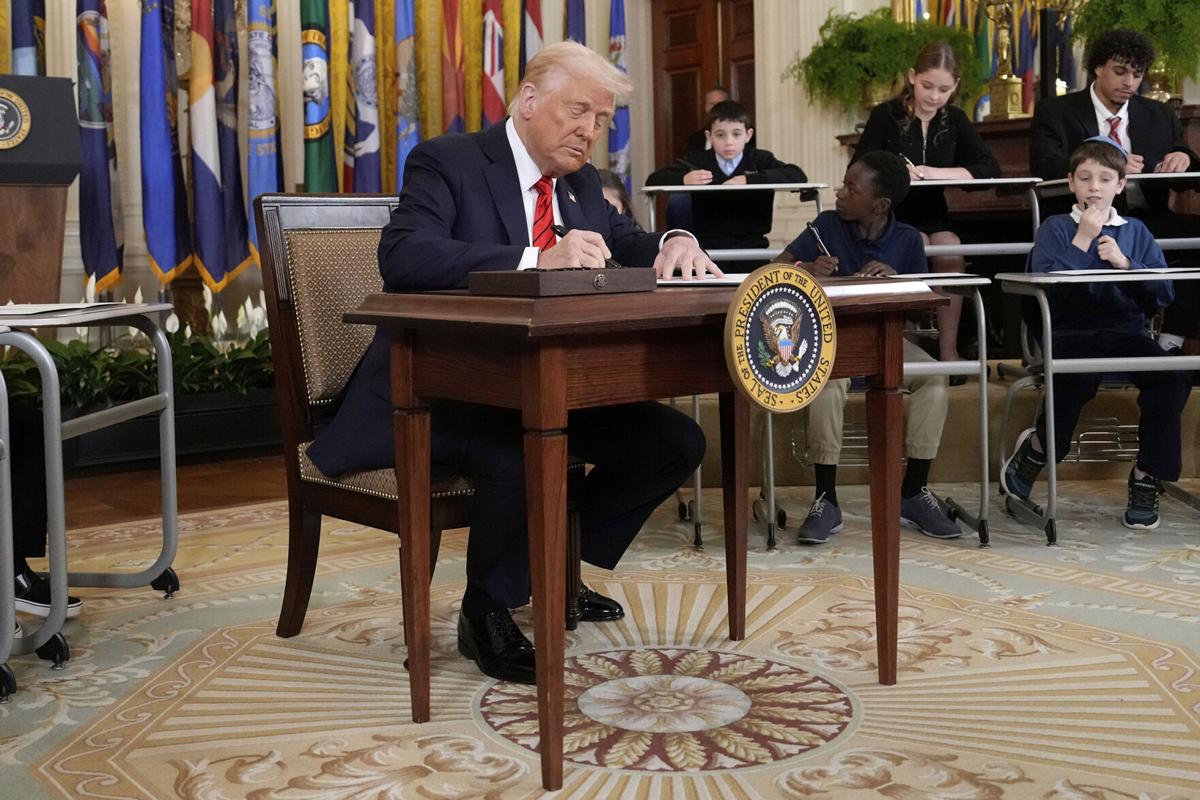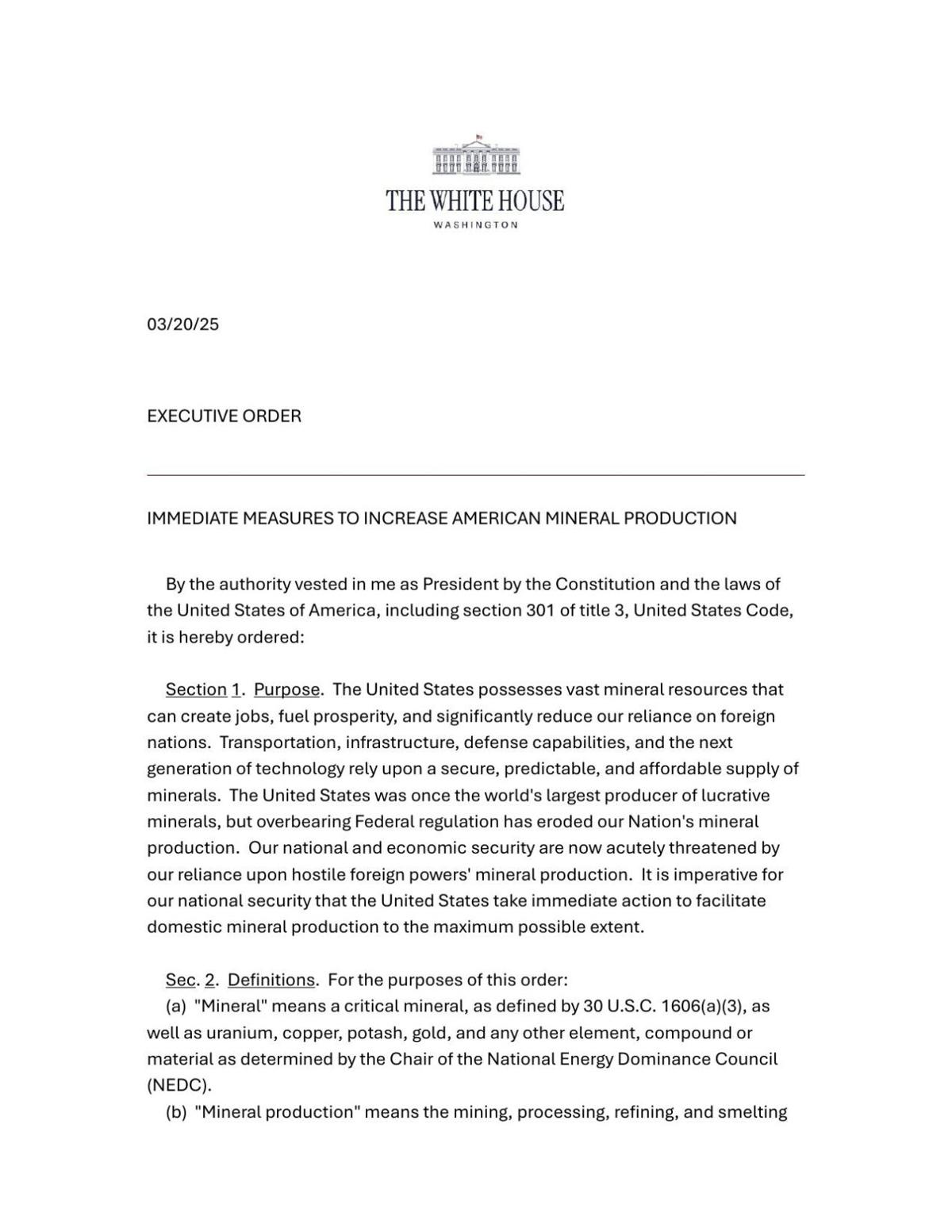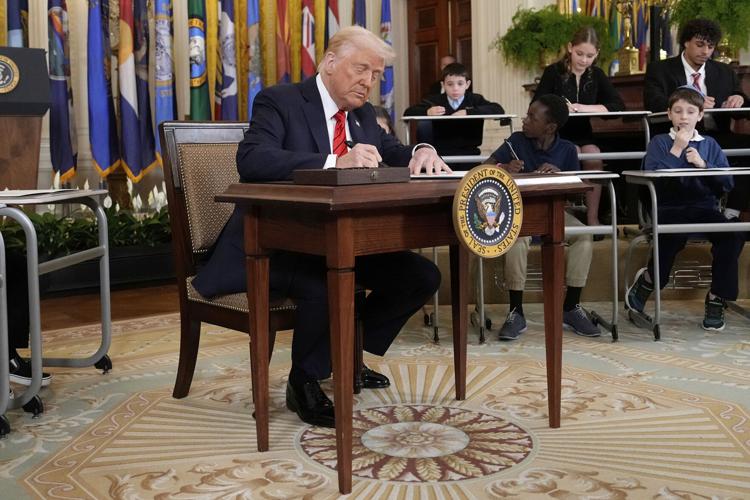President Donald Trump signed an executive order on March 20 aiming to speed up the process of developing mines in the United States.
The order gives short timelines for developing lists of mining projects that should be fast-tracked and lists of public lands where mineral production should be the top priority.
The executive order, titled “Immediate measures to increase American mineral production,” declares a national energy emergency and uses provisions in the order and the Defense Production Act, which was passed in 1950, to facilitate the advancement of domestic mineral production and promote the acceleration of the development of new mines.
The new executive order on mineral production opens with a statement of purpose saying, “The United States possesses vast mineral resources that can create jobs, fuel prosperity, and significantly reduce our reliance on foreign nations. Transportation, infrastructure, defense capabilities, and the next generation of technology rely upon a secure, predictable, and affordable supply of minerals.
“The United States was once the world’s largest producer of lucrative minerals, but overbearing federal regulation has eroded our nation’s mineral production,” the order says. “Our national and economic security are now acutely threatened by our reliance upon hostile foreign powers’ mineral production. It is imperative for our national security that the United States take immediate action to facilitate domestic mineral production to the maximum possible extent.”
Rich Nolan, president and CEO of the National Mining Association, praised the executive order.
“Ramping up American mining is a national security imperative, and President Trump’s strong action recognizes that,” Nolan said. “By encouraging streamlined and transparent permitting processes, combined with financing support to counter foreign market manipulation, we can finally challenge China’s mineral extortion.
“We applaud this strong action that confronts our mineral crisis head on and we look forward to working with the administration to ensure made in America increasingly means mined in America.”
Amanda Hilton, the president of the Nevada Mining Association, said that "streamlining domestic mineral production is essential to the future of our national security, transportation, and energy needs, as well as the everyday products and technologies we rely on.
"Nevada is uniquely positioned to lead the way, mining more than 20 minerals with the potential to produce even more. With world-class production, sustainability, and safety standards, Nevada’s mining industry is ready to meet our national mineral needs today and in the future." Hilton said.

Members of the Surge Battery Metals team visit the Nevada North Lithium Project in northern Elko County.
Greg Reimer, the president and CEO of Surge Battery Metals, which is developing the Nevada North Lithium Project in northeast Elko County, said, "This executive order undeElrscores the importance of projects like ours in reducing reliance on foreign sources and bolstering national security. We are committed to advancing our project responsibly and sustainably, contributing to the local economy and supporting the nation's clean energy goals."
Mark A. Smith, executive chairman and CEO of NioCorp Developments, which is developing the Elk Creek Critical Minerals Project in Nebraska, where niobium, scandium, and titanium will be produced, said, “With this executive order, President Trump has launched a new era of ‘Mine, Baby, Mine’ in America.”

NioCorp Developments says the niobium, scandium and titanium which will be mined at its Elk Creek Critical Minerals Project in Nebraska are vital to America’s defense, transportation, infrastructure and clean energy future.
“The president wants to build entire critical minerals supply chains in the U.S. from the mine to the M1 tank,” Smith said. “His whole-of-government approach to re-shoring these supply chains will help de-risk the entire sector, which in turn is expected to attract significant new private capital into mining and mineral processing supply chains.”
Jon Cherry, the president and CEO of Perpetua Resources, which is developing the Stibnite Gold Project in Idaho, said the executive order “is a resounding endorsement of American mining, and the Stibnite Gold Project is a prime example of why critical mineral production in America requires immediate attention and prioritization.”
“We are very encouraged to see this action to unlock a new era of American critical mineral dominance,” Cherry said.

A view of the old pit and workings in the area which Perpetua Resources is working toward developing as the Stibnite gold and antimony mine. Perpetua has received the Final Record of Decision from the U.S. Forest Service for the project in the mountains of north central Idaho.
When the Stibnite Gold Project begins production, which may happen in 2028, it is expected to become the only U.S. mined source of antimony, a mineral used in many technology and defense applications.
Mckinsey Lyon, Perpetua Resources’ vice president of external affairs, testified before the U.S. House Committee on Natural Resources Subcommittee on Energy & Mineral Resources on Feb. 6, saying, “Our anticipated 18-year timeline from prospecting to production is just too long. Our nation can’t wait 18 years to bring critical resources online.”
Environmental groups, however, said the new executive order will strip away environmental protections and threaten communities and public lands.
“With this destructive order, Trump is slapping a giant ‘Free Stuff’ sign on America’s public lands,” said Taylor McKinnon at the Center for Biological Diversity. “Giving these beautiful places away to rich mining companies will contaminate water supplies, push imperiled animals like salmon and jaguars toward extinction, and transform our public lands into industrial wastelands.”
“These cherished landscapes are part of every American’s natural heritage, and Trump has no right to just hand them over to giant mining corporations,” McKinnon said.
“Yet again, President Trump is trying to ignore the law and dictate that our national public lands be handed over to private companies for extraction and profit above all else,” Rachael Hamby, the policy director at the Center for Western Priorities, said. “This short-sighted approach shows a shocking disregard for Congress, federal land management agency rules and regulations, and public opinion.”
She said the order “is clearly about enriching mining companies and their shareholders, not enhancing national security. Removing safeguards for mining on our public lands is a bad move that puts wildlife and communities in danger and will be met with fierce resistance across the West.”
Roger Featherstone, the executive director of the Arizona Mining Reform Coalition, said the people involved in putting together the executive order on mineral production "really don’t know what the hell they’re doing. The timelines are nonsensical, expecting the agencies to do all this work while their staffs are decimated and on these incredibly short timelines is just ridiculous.”
Ronni Flannery, a senior staff attorney at the Wilderness Society, said, “Few things unite this country like the love of our public lands and the outdoors, but today, the administration opened yet another front in its efforts to sell these places off for development - this time to move mining projects forward at warp-speed for the good of international mining corporations.
"This executive order represents one of the most brazen attempts to expand mining on public lands in more than a century, in line with the administration’s push to privatize our shared public lands," Flannery said. "And it could end up posing significant risks to lands, waters, wildlife and the communities that rely on them, both in the present day and for generations to come.”

Integra Resources is continuing to develop its Nevada North project, which is about 30 miles west of its recently acquired producing Florida Canyon gold mine in Pershing County.
The executive order applies not only to materials that have previously been defined as critical minerals, but also to “uranium, copper, potash, gold and any other element, compound or material as determined by the chair of the National Energy Dominance Council.”
The council was established by an executive order on Feb. 14, and Interior Secretary Doug Bergum serves as its chair.
The March 20 executive order on mineral production says that within 10 days, the head of each agency involved in permitting mineral production projects must provide a list of all projects which are in the permitting process, and within another 10 days, “the head of each such agency shall, in coordination with the chair of the NEDC, identify priority projects that can be immediately approved or for which permits can be immediately issued, and take all necessary or appropriate actions within the agency’s authority to expedite and issue the relevant permits or approvals.”
The order says the council’s chair, in consultation with agencies, will “issue a request for information to solicit industry feedback on regulatory bottlenecks and other recommended strategies for expediting domestic mineral production.”
A section of the order appears to address the Rosemont decision of 2019, which said mining companies can only dump waste on federal lands where there are valid mining claims and valuable minerals. Mining advocates have said the Rosemont decision will place prohibitive restrictions on many mining projects, and several attempts have been made to reverse the effects of the decision. The new mineral production executive order says the council’s chair and the director of the Office of Legislative Affairs will “jointly prepare and submit recommendations to the President for the Congress to clarify the treatment of waste rock, tailings, and mine waste disposal under the Mining Act of 1872.”
The new executive order also says that within 10 days, “the Secretary of the Interior shall identify and provide the Assistant to the President for Economic Policy and the Assistant to the President for National Security Affairs with a list of all Federal lands known to hold mineral deposits and reserves. The Secretary of the Interior shall prioritize mineral production and mining related purposes as the primary land uses in these areas, consistent with applicable law.”
The Center for Western Priorities said this section of the executive order “flies in the face of federal land management agencies’ enabling laws, which clearly state the intent of Congress that national public lands be managed for multiple uses and that it is up to the agencies, with input from the public, to balance those uses to ensure a sustained yield of natural resources.”
The executive order also says that within 30 days the secretaries of various agencies need to put together lists of federal lands that may be suitable for leasing or development by private commercial mineral development enterprises, and then they need to prioritize the sites on these lists “on which mineral production projects could be fully permitted and operational as soon as possible and have the greatest potential effect on robustness of the domestic mineral supply chain.”
A variety of funding mechanisms for developing mining projects are also addressed by the order. The order says the secretaries of Defense, Energy and Agriculture and the administrator of the Small Business Administration will work together with the heads of agencies that can provide “loans, capital assistance, technical assistance, and working capital to domestic mineral production project sponsors to ensure that all private parties who enter into lease and commercial agreements … can utilize as many favorable terms and conditions as are available under public assistance programs for these purposes, consistent with applicable law.”
The order also says the secretary of Defense will “utilize the National Security Capital Forum to facilitate the introduction of entities to pair private capital with commercially viable domestic mineral production projects to the maximum possible extent.”
Also, the order says that within 30 days the CEO of the U.S. International Development Finance Corporation and the secretary of Defense will develop a plan for the finance corporation to use Department of Defense investment authorities and the Department of Defense Office of Strategic Capital to establish a dedicated mineral and mineral production fund for domestic investments executed by the corporation.













